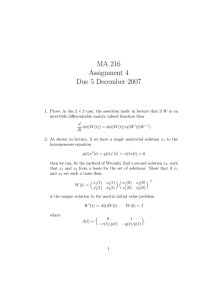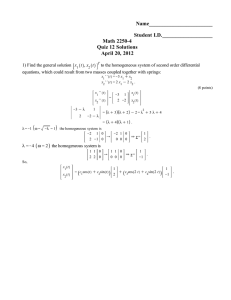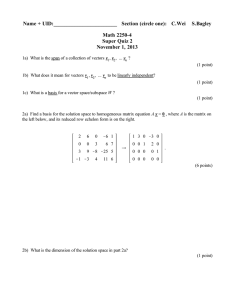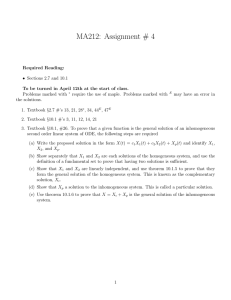Week 3, Part 2: Linear difference equations
advertisement
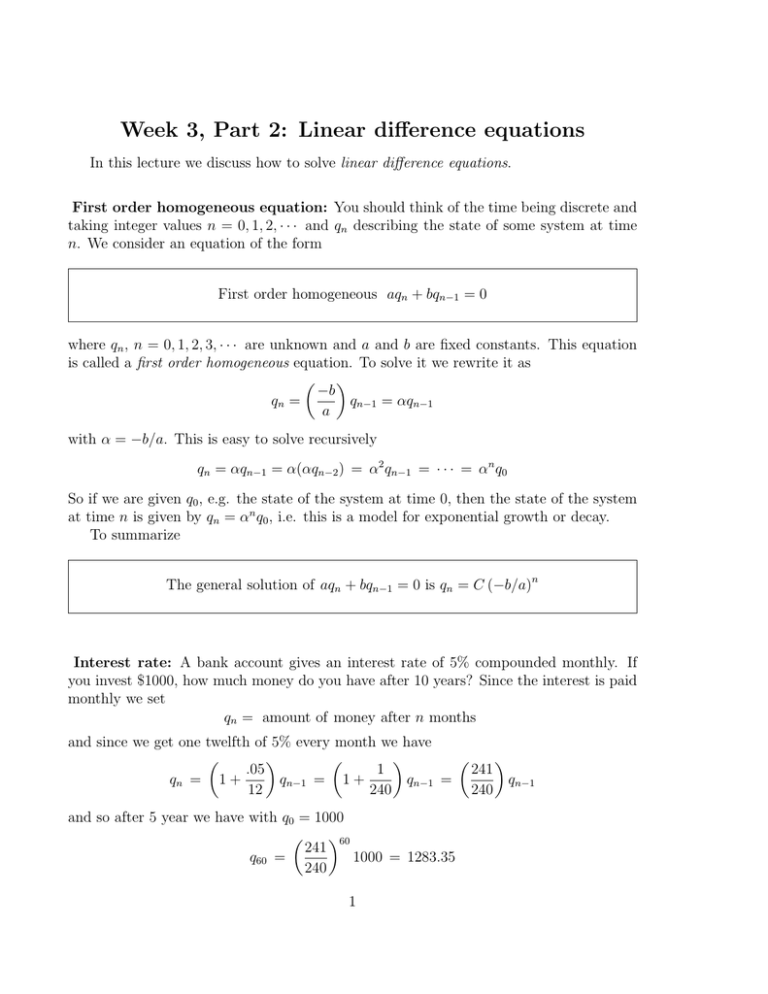
Week 3, Part 2: Linear difference equations In this lecture we discuss how to solve linear difference equations. First order homogeneous equation: You should think of the time being discrete and taking integer values n = 0, 1, 2, · · · and qn describing the state of some system at time n. We consider an equation of the form First order homogeneous aqn + bqn−1 = 0 where qn , n = 0, 1, 2, 3, · · · are unknown and a and b are fixed constants. This equation is called a first order homogeneous equation. To solve it we rewrite it as −b qn = qn−1 = αqn−1 a with α = −b/a. This is easy to solve recursively qn = αqn−1 = α(αqn−2 ) = α2 qn−1 = · · · = αn q0 So if we are given q0 , e.g. the state of the system at time 0, then the state of the system at time n is given by qn = αn q0 , i.e. this is a model for exponential growth or decay. To summarize The general solution of aqn + bqn−1 = 0 is qn = C (−b/a)n Interest rate: A bank account gives an interest rate of 5% compounded monthly. If you invest $1000, how much money do you have after 10 years? Since the interest is paid monthly we set qn = amount of money after n months and since we get one twelfth of 5% every month we have .05 1 241 qn = 1 + qn−1 = 1 + qn−1 = qn−1 12 240 240 and so after 5 year we have with q0 = 1000 60 241 q60 = 1000 = 1283.35 240 1 First order inhomogeneous equation: Let us consider an equation of the form First order inhomogeneous aqn + bqn−1 = cn , where cn is a given sequence and qn is unknown. For example we may take cn = c , cn = cn , cn = cαn . This equation is called inhomogeneous because of the term cn . The following simple fact is useful to solve such equations Linearity principle: Suppose q̂n be a solution of the inhomogeneous aqn + bqn−1 = cn and q̃n be a solution of the homogeneous equation aqn +bqn−1 = 0 then qn + q̃n is a solution of the inhomegenous equation aqn + bqn−1 = cn . Indeed we have aq̂n + bq̂n−1 aq̃n + bq̃n−1 = cn = 0 and thus adding the two equations give a(q̂n + q̃n ) + b(q̂n−1 + q̃n−1 ) = cn (1) To find the general solution of a first order homogeneous equation we need • Find one particular solution of the inhomogeneous equation. • Find the general solution of the homogeneous equation. This solution has a free constant in it which we then determine using for example the value of q0 . • The general solution of the inhomogeneous equation is the sum of the particular solution of the inhomogeneous equation and general solution of the homogeneous equation. Example: Solve aqn + bqn−1 = c i.e., the inhomegenous term is cn = c i.e. constant. We look for a particular solution, and after some head scratching we try qn = d to be constant and find ad + bd = c , or d = 2 c a+b The general solution is then qn = C(−b/a)n + c . a+b 2qn − qn−1 = 2n , q0 = 3 Example: Solve The solution of the homogenous is q n = C(1/2)n . To find a particular solution of the inhomogeneous problem we try an exponential function qn = D2n with a constant D to be determined. Plugging into the equation we find 2D2n − D2n−1 = 2n or after dividing by 2n−1 4D − D = 2 or D = So the general solution is 2 . 3 n 1 2 qn = C + 2n . 2 3 and the initial condition gives q0 = 3 = C + 23 and so n 2 7 1 + 2n . qn = 3 2 3 More interest rate: A bank account gives an interest rate of 5% compounded monthly. If you invest invest initially $1000, and add $10 every month. How much money do you have after 10 years? Since the interest is paid monthly we set qn = amount of money after n months and we have the equation for qn 241 .05 qn−1 + 10 = qn−1 + 10 qn = 1 + 12 240 For the particular solution we try qn = d and find d= 241 d + 10 240 i.e., d = −2400. The general solution is then n 241 qn = C − 2400 240 3 and q0 = 1000 gives qn = 3400 241 240 n − 2400 and so q60 = 1963.41 Second order homogeneous equation: We consider an equation where qn depends on both qn−1 and qn−2 : Second order homogeneous aqn + bqn−1 + cqn−2 = 0 . It is easy to see that we are given both q0 and q1 we can determine q2 , q3 , and so on. Linearity Principle: It is easy to verify that if q̃n and q̂n are two solutions of the second order homogeneous equation. Then C1 q̃n +C2 q̂n is also a solution for any constant C1 , C2 . To find the general solution we get inspired by the homogeneous first order equation and look for solutions of the form q n = xn If we plug this into the equation we find aαn + bαn−1 + cαn−2 and dividing by αn−2 give ax2 + bx + c = 0 We find (in general) two roots x1 and x2 and the general solution has the form qn = C1 xn1 + C2 xn2 Example: The Fibonnaci sequence is given by qn = qn−1 + qn−2 , q0 = 0, q1 = 1 that is every term of the sequence is the sum of the two preceding terms. It is given by 0, 1, 1, 2, 3, 5, 8, 13, 21, 34, 55, 89, 144, 233 · · · The golden ratio √ 1+ 5 ϕ = = 1.61803398875 2 4 occurs in the Fibonnacci sequence in the sense that for large n qn+1 ≈ ϕ. qn For example 89/55 = 1.61818181818, 144/89 = 1.61797752809, 233/144 = 1.61805555556, and so on... To see why it occurs we solve the second order difference equation: with qn = αn we find α2 − α − 1 = 0 or √ 1± 5 α = 2 So the the general solution is q n = c1 √ !n 1+ 5 + c2 2 and with q0 = 0 and q1 = 1 we find " √ !n 1 1+ 5 qn = √ − 2 5 √ !n 1− 5 . 2 √ !n # 1− 5 . 2 √ Since | 1−2 5 | < 1 the second term is vanishingly small for large n so qn ≈ √1 5 √ n 1+ 5 . 2 Second order inhomogeneous equation: We consider an equation of the form Second order homogeneous aqn + bqn−1 + cqn−2 = dn . where qn is unknown and dn is a fixed sequence. As for first order equations we can solve such equations by 1. Solve the homogeneous equation aqn + bqn−1 + cqn−2 = 0. 2. Find a particular solution of the inhomogeneous equation. 3. Write the general solution as the sum of the particular inhomogeneous equation plus the general solution of the homogeneous equation. 5 Example: Find the general solution of the second order equation 3qn +5qn−1 −2qn−2 = 5. For the homogeneous equation 3qn + 5qn−1 − 2qn−2 = 0 let us try qn = xn we obtain the quadratic equation 3x2 + 5x − 2 = 0 or x = 1/3, −2 and so the general solution of the homogeneous equation is n 1 + C2 (−2)n qn = C 1 3 For a particular equation 3qn + 5qn−1 − 2qn−2 = 5 we try qn = D and find 3D + 5D − 2D = 5 i.e. D = 5/6 and so the general solution is n 5 1 qn = + C 1 + C2 (−2)n 6 3 Exercise 1: Solve the following difference equations 1. 2qn − 5qn−1 = 0, q0 = 2 2. 2qn − 5qn−1 = 3, q0 = 3 3. 2qn+1 − 7qn + 3qn−1 = 0, q0 = 1, q1 = 2 4. 2qn+1 − 7qn + 3qn−1 = 2 + 2n , q0 = 1, q1 = 2 Exercise 2: Your mortgage is a 30 year fixed rate mortgage at an (fixed) annual rate of 4% compounded monthly. 1. If you borrow $150’000 today, what is the total amount of money will you pay back to the bank during the next 30 years? 2. You decide that you can make a down-payment of $15000 and that $1250 is the maximal monthly payment you are willing to commit to. What is the value of the most expensive house can you buy? 6 Exercise 3: Your retirement account has a fixed rate of 8% per year paid yearly. You start saving for retirement at age 30 with a target retirement age of 65 and $0 in your saving account. Set-up and solve a suitable first order difference equations to answer the following questions (compute all interests and payment on a yearly basis). 1. Suppose you set aside $500 every month. How much money will you have for your retirement? 2. You want to retire with $500’000. How much should you save every month? 3. Assuming that your salary is going to increase 5 % per year during your lifetime you also decide you contribution should follow suit and your monthly contribution increase by 5% every year. If your starting contribution is $500 every month how much money will you have saved at retirement age? 4. Assuming again that your contribution is increasing by 5% every year, what should your starting contribution be if if you want to reach $500’000 by retirement age? Exercise 4: After winning the $ 200 million jackpot at the Powerball lottery you are given the choice to either receive the lump sum of $ 100 million or to receive $ 10 million per year for the next 20 years. You go first to a financial advisor who tells you that you can invest our money with him and receive an interest rate of α percent yearly (compounded annually). To compare your two options and because you are an extremely thrifty individual you decide to invest all your money for the next 20 years. Write down difference equations for the two options (denote by qn the value of investment after n years in million dollars). For which interest rate α is the option of lump sum better? 7
